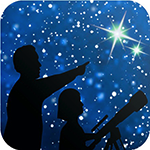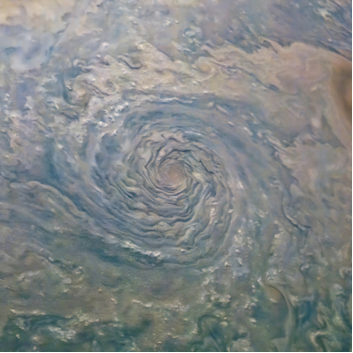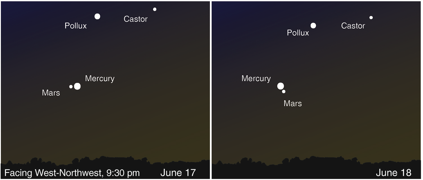Jupiter stakes its claim as the king of the planets in June, shining bright all night. Saturn trails behind Jupiter, and the Moon passes by both planets mid-month. Mercury puts on its best evening appearance in 2019 late in the month, outshining nearby Mars at sunset.
Jupiter is visible almost the entire evening this month. Earth will be between Jupiter and the Sun on June 10, meaning Jupiter is at opposition. On that date, Jupiter rises in the east as the Sun sets in the west, remaining visible the entire night. Jupiter will be one of the brightest objects in the night sky, shining at magnitude -2.6. Its four largest moons and cloud bands are easily spotted with even a small telescope.
What if your sky is cloudy or you don’t have a telescope? See far more of Jupiter than we can observe from Earth with NASA’s Juno mission! Juno has been orbiting Jupiter since 2016, swooping mere thousands of miles above its cloud tops in its extremely elliptical polar orbits, which take the probe over 5 million miles away at its furthest point! These extreme orbits minimize Juno’s exposure to Jupiter’s powerful radiation as it studies the gas giant’s internal structure, especially its intense magnetic fields. Juno’s hardy JunoCam instrument takes incredible photos of Jupiter’s raging storms during its flybys. All of the images are available to the public, and citizen scientists are doing amazing things with them. You can too! Find out more at bit.ly/JunoCam
Saturn rises about two hours after Jupiter and is visible before midnight. The ringed planet rises earlier each evening as its own opposition approaches in July. The Moon appears near both gas giants mid-month. The Moon’s tour begins on June 16 as it approaches Jupiter, and its visit ends on June 19 after swinging past Saturn.
Mercury is back in evening skies and will be highest after sunset on June 23, just two days after the summer solstice! Spot it low in the western horizon, close to the much dimmer and redder Mars. This is your best chance this year to spot Mercury in the evening, and nearly your last chance to see Mars, too! The two smallest planets of our solar system pass close to each other the evenings of June 17-18, coming within just ¼ degree, or half the width of a full Moon, making for a potentially great landscape photo at twilight.
Discover more about NASA’s current and future missions at nasa.gov
Caption: A giant storm in Jupiter’s north polar region, captured by JunoCam on February 4, 2019. Image processing performed by citizen scientists Gerald Eichstädt and Seán Doran.
Source: bit.ly/JupiterSpiral
Caption: Mars and Mercury after sunset the evenings of June 17-18, 2019. Image created with assistance from Stellarium.
This article is distributed by NASA Night Sky Network
The Night Sky Network program supports astronomy clubs across the USA dedicated to astronomy outreach. Visit nightsky.jpl.nasa.org to find local clubs, events, and more!



